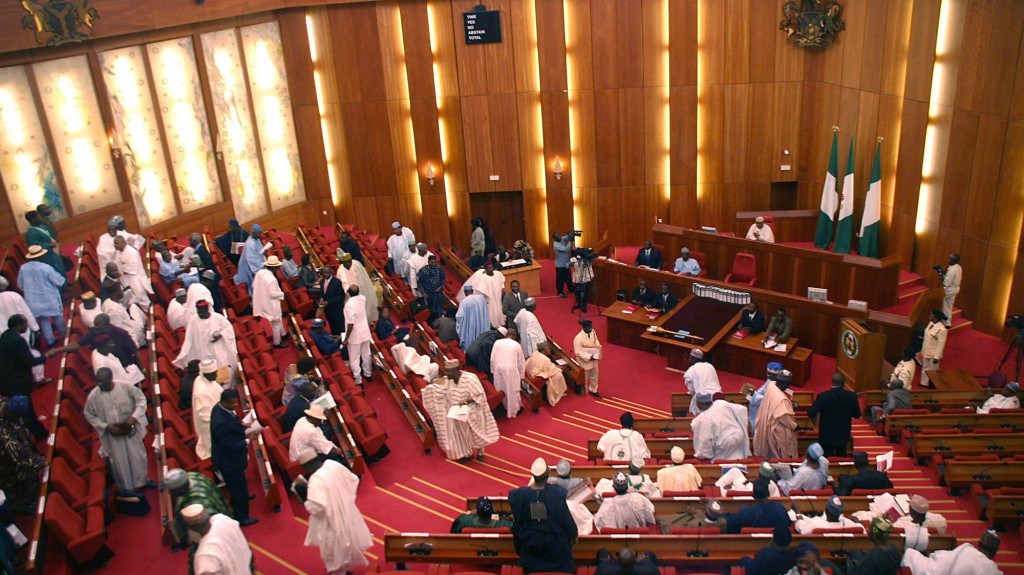
The Senate and the House of Representatives have concluded voting on the amendment to aspects of the 1999 Nigerian Constitution.
Altogether, the two chambers of the National Assembly considered 33 sections of the document slated for amendment in the Constitution of the Federal Republic of Nigeria (Fourth Alteration) Bill, 2017.
Among the major ammendments passed are the abrogation of state/local government joint accounts and the existence of democratically-constituted local government areas as well as expansion of the membership of the Council of State to include former Senate Presidents and Speakers of the House of Representatives.
Others are the inclusion of portfolios of ministerial nominees before sending them to the National Assembly for confirmation; sending ministerial and commissioner nominees within 30 days of the inauguration of the president and of governors for states; and empowering the Independent National Electoral Commission, INEC, to deregister political parties over failure to secure an elective seat.
Already, the legislature voted in favour of local government autonomy; immunity for lawmakers in respect of words spoken or written at the plenary session; the president to deliver a State of the Nation address to joint session of the National Assembly; as well as independent candidacy for elections
Significantly, both chambers rejected devolution of power to the federating states.
The legislature derives its authority from Section 9 (2) and (3) to amend the Constitution.
Section 9 states that the “National Assembly can pass an Act to amend the Constitution when its proposal to amend the constitution has been supported by two-thirds majority of all the members of each chamber and is approved by the resolution of at least 24 Houses of Assembly at the states.”
However, the amendments approved by the federal legislature is just one of the steps in the process to alter the constitution as there are stages they would go through before they finally take effect.
Procedures for a constitutional amendment:
1. Amendments to the Constitution come in form of Bills, which originate either from the executive arm or the legislative arm (as a Private Member Bill).
Private Member Bill can be initiated by any member of the Senate and House of Representative or interest groups through the lawmakers.
Both the Senate and House of Representatives which have separate committees on the review of the constitution may have taken inputs from members of the public via public hearings.
2. Voting process takes place in both chambers of the National Assembly. Each of the amendments will only scale through if it gets the support of two-thirds of each of the chambers (240 in the House, 72 in the Senate). Once the voting is concluded in the Senate, it is sent to the House of Representatives for concurrence or vice versa.
3. Once all the proposed amendments are accepted by two-thirds of each of the chambers, the Bill is sent to the Clerk of the National Assembly, CNA to transmit to the State Houses of Assembly.
4. Once the process is completed at the National Assembly, the amendments are forwarded to the State Houses of Assembly.
Here two-thirds (24) of the 36 states must approve each clause by a vote of a simple majority.
Once this is achieved, the amendment takes effect and returns are made to the National Assembly.
Any amendment not ratified by at least 24 state legislatures is presumed dead and may have to wait for future exercises.
5. Presidential Assent: Once the Bill is returned to the National Assembly from the state legislatures, it is sent to the president for assent.
However, shortly after the last amendment exercise, there was a raging debate as to whether the amendments should automatically take effect or it should be sent to the president for assent.
In 2015, former President Goodluck Jonathan had withheld his assent to the Constitution of the Federal Republic of Nigeria (Fourth Alteration) Act 2015 sent to him by the National Assembly.
He queried the decision of the National Assembly to whittle down some executive powers of the president of the country.
In May that year, a few days before Mr. Jonathan vacated office, the Supreme Court to which the matter was referred ordered both federal government and the National Assembly to maintain status quo on the amendment exercise.
Interestingly, in the current exercise, both chambers have voted to support overriding presidential veto in constitutional alteration.
END

Be the first to comment